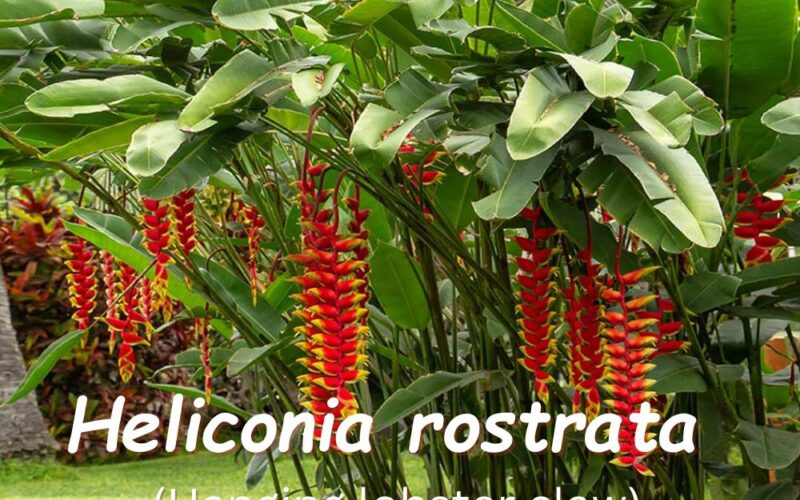If you can provide a sunny place Heliconia rostrata (Hanging Lobster Claw) can be excellent for those who are fans of rare Plants. Please regularly water your Heliconia rostrata (especially in summer and warm days), although you should allow the soil to dry out between waterings to prevent root rot. A rich and well-drained soil will help you with this issue. Keep reading to tell you everything about Hanging Lobster Claw plant growth and even more.
Heliconia rostrata belong to the genera Heliconias. This genus is related to known plants such as bananas, cannas and gingers. There are about 100 species of tropical plants in Heliconias Heliconia rostrata is the most famous ornamental and cultivated species. Some species such as Heliconia bihai grow in an upright position.

This tropical plant is also known as “Hanging lobster claw” and “False bird of paradise” due to the shape of its flowers and leaves.
In this article, we will tell you about the appearance, habitat and caring points that you should know about Hanging lobster claws.
If you are ready, let’s get on with it then.
The Appearance of Heliconia rostrata (Hanging Lobster Claw)
Heliconia rostrata is an evergreen herbaceous perennial tropical plant. In the following, I will tell you more details about its appearance. So, keep reading. The main parts of this plant are:
- The rhizomatous
- The petioles
- The leaves
- The flowers and fruits
Heliconia rostrata height:
The “False bird of paradise” can belong to tall plants which can grow up to 4-6 ft. (120-180 cm) tall.
The rhizomatous:

It is an underground system of rhizomes (a type of root) that the petioles of Hanging lobster claw grow directly from it. Have you ever seen a rhizome? I am sure you have seen it in Ginger. Indeed, the Ginger that you use for cooking is a piece of rhizome.
The leaves:

Its large leathery, banana-like leaves are dark green. The leaves develop from the long Petioles that are raised directly from the rhizomatous.
The flowers:
The wonderful flowers of “Hanging lobster claw” will appear in spring and summer that can last for weeks.
The flowers grow on long stems (3-5 ft. or 90-150 cm) that arise from rhizomatous.

The colourful thing that people assume is the flower of Heliconia rostrata is the colourful bracts (a group of specialised leaves) that make the inflorescence and true flowers are hidden inside them.
The bracts are bright red with yellow to green tips that support the yellowish-white flowers. In the following, we will also repeat this common mistake and call these colourful bracts downward-facing flowers.
The fruits:
The dark blue fruits are fleshy and rounded.

The Wonderful Facts:
The bracts are cup-shaped that can store water for birds and insects. The flowers produce nectars that attract birds, especially hummingbirds. Hence this plant can be supposed as a host flower to many birds.
Habitat of Heliconia rostrata (hanging lobster claw)
Heliconia rostrata is a tropical plant that is native to Bolivia, Colombia, Ecuador and Peru and is the national flower of Bolivia too. so, this plant cannot tolerate cold weather and require a warm and humid environment to grow.
How to Care for Heliconia rostrata (Hanging Lobster Claw)
In this part, you will find everything you should know about caring for and growing a Hanging Lobster Claw including its lighting, watering and other requirements.

Lighting Requirements of False Bird of Paradise
False Birds of Paradis is not a low-light houseplant. This plant loves to grow in full sun, however it can tolerate slight shade but not low-light places. If you put them in shadier areas, they tend to grow taller and taller.
Watering Requirements of False Bird of Paradise
There are two important points that you should take note of for watering this plant:
- Heliconia rostrata is a heavy feeder plant, so, it needs a lot of water with regular watering. It would be best to wait until the top soil partially dries up between watering to decrease root rot disease, although you must avoid a heavy dry. Especially you must do abundant watering in summer.
- Although Heliconia rostrata needs a lot of water, to be sure about draining. This plant needs to grow in freely draining soils. It would help if you grow them on slopes to ensure about soil’s draining. In addition, avoid planting them in pots without holes.
The Best Soil for the False Bird of Paradise
The moist soils with high organic matter and good draining are perfect for growing “Hanging lobster claw”. So, Humus-rich soils that are acidic or neutral can be best for them. Adding mulch to the soil will improve the texture of the soil, enhance its organic matter and prevent drying out the soil.
Fertilizing Requirements of False Bird of Paradise
In the following you can find some of the best fertilizers for “Hanging lobster claw”:
- chicken pellets
- complete fertilizer blends
- Slow-released fertilizers balanced with microelements.
Propagating Method of False Bird of Paradise
There are two ways to Propagate Heliconia rostrata: seed and rhizomes division. Both of them must be done in spring.
Propagating by seed:
It is not a common way to propagate Heliconia rostrata because of:
- Growing from seed is seldom.
- Most species don’t produce growable seeds.
- It may take years to germinate seeds.
- The germination percentages are low.
- The plants that grow from seeds may be different from their parents.
Propagating by rhizomes division:

It is the most common way to propagate Heliconia rostrata. In this way, the new plant will be similar to its mother. To perform it you must cut a section of the rhizome and then plant it and support it for at least two months.
Pest and Disease of False Bird of Paradise
In the following, you can see the most common pests (tiny bugs on your plant) and diseases of Hanging lobster claws:
- Glasshouse red spider mites
- Grasshoppers
- Mealybugs
- Snails
- Phytophthora root rot
- Pythium stem
Pruning Tips for False Bird of Paradise
Prune of Heliconia rostrata is not common because its leaves and flowers arise directly from the rhizomes. So, things that you suppose as stems are petioles. However, each pseudostem will only flower once, hence, pruning of flowering stems, and damaged or dying leaves is recommended because:
- It will encourage more flowering.
- It will increase airflow between the leaves.
- It improves the appearance of your plant.
Conclusion
You got familiar with Heliconia rostrata (“Hanging lobster claw” or “False bird of paradise”). You found out its needs and learned how to care for and grow this rare plant. In addition, you now know more details about its appearance and habitat.
Do you have one of them in your indoor or outdoor tropical garden? do you want to buy one of them? please share your ideas and experiences with our readers below this page.

Elahe Rabiei
Hi, I’m Elaheh. My Academic major is plant protection, and houseplants are my expertise. As a houseplant lover, my house is full of indoor plants and it is my passion to take care of them. Hence, I’m here to share my knowledge and experience about growing healthy houseplants. I am also a plant protection advisor, so feel free to ask me any questions you may have.

